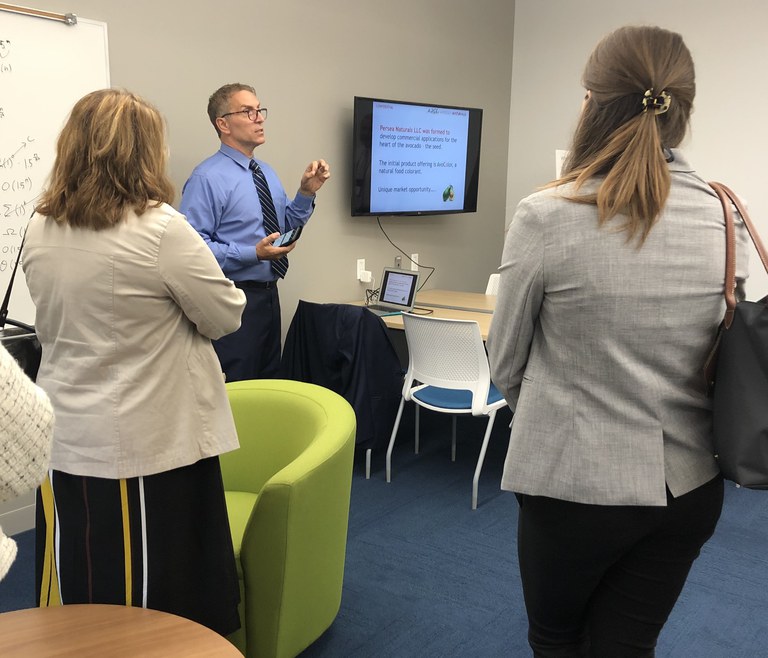Posted: November 13, 2019
College of Ag Sciences researchers who are commercializing their discoveries presented their ventures to VIPs during the Invent Penn State Venture & IP Conference

Bob Hicks, CEO of Persea Naturals, producer of AvoColor®, explains the company's full spectrum of orange, yellow and red hues that can be used as natural food color.
About 25 investors and entrepreneurs learned how three researchers at the College of Agricultural Sciences are commercializing their discoveries of a natural food color developed from avocado pits, a bio-pesticide for bed bugs and making bio-plastic from cellulose during a tour in early October.
The guests, who were attending the Invent Penn State Venture & IP Conference, held Oct. 3-4 at the Penn Stater, visited the researchers Oct. 3 at the newly renovated Agricultural and Biological Engineering Building. Dr. Maria Spencer, the college's John and Patty Warehime Entrepreneur-in-Residence, organized and led the tour.
Attendees said the tour was valuable and worthwhile.
Duane Stewart, an attorney at Buchanan Ingersoll and Rooney in Pittsburgh, said he enjoyed learning more about the technologies and that it was encouraging to see how the three ventures have developed and progressed since he first heard some of the presenters in spring 2018 at the first IPS Venture & IP Conference.
Sarah Phillips, a law student at Penn State Dickinson Law in Carlisle, said learning about the solutions made her feel hopeful. “I didn't realize how much work was going on to solve these problems at this level," she said.
Making Bioplastics from Cellulose
Dr. Jeff Catchmark, materials scientist and professor of agricultural and biological engineering, explained his work to make bioplastics out of cellulose. Catchmark and his team discovered that applying electrostatic charges to pairings of polysaccharides “locks" them together to make a durable and biodegradable material that can be used in foams and gels. Catchmark's biomaterial can potentially be used as a compostable food container and to replace plastic microbeads in cosmetic products — one of the insidious sources of global plastic pollution in rivers, lakes and oceans.
Stephen Spoonamore, president and CEO of Additive Circuits Technologies in Los Angeles, works to find materials to reduce electronic waste. He was fascinated by Catchmark's work in biodegradable materials, and glad to see engaged faculty and their success stories emerging from research at the college.
The commercial value of the research discoveries is clear, said Spoonamore.
Natural Food Color Found in Avocado Pits
Bob Hicks, CEO of Persea Naturals, producer of AvoColor®, told the company's story: Dr. Greg Ziegler, a food scientist, noticed that when avocado pits are pulverized, an enzymatic reaction produces a bright orange color that's difficult to wash away. Ziegler and Joshua Lambert, associate professor of food science did further research to prove the stability of the color and the full spectrum of orange, yellow and red hues that can be used as natural food color.
Hicks explained how major food manufacturing companies are looking for natural sources of color for their products.
“Food color companies are very anxious to find solutions," said Hicks. AvoColor® provides vibrant colors that are cover 40 percent of the color spectrum and maintain stability when combined with heat, light, acid and oxygen.
The US Department of Agriculture's National Institute of Food and Agriculture in September awarded Persea Naturals a Small Business Innovation Research Phase II grant to support commercialization of AvoColor®.
Non-toxic Bed Bug Solution
Entomologist Dr. Nina Jenkins, explained how funding from the College of Agricultural Sciences RAIN grant program enabled her to tackle key regulatory hurdles for commercialization of a fungal biopesticide technology that she had developed for bed bugs. With this assistance and coaching in entrepreneurship from the Ben Franklin TechCelerator course, she established ConidioTec LLC.
The product, Aprehend®, is now registered with the US EPA and sold to licensed pest control operators in all 50 U.S. states, the District of Columbia and Puerto Rico.
Aprehend® not only has a non-toxic mode of action, but also saves time and labor for both the pest control operator and homeowner. The spray has a three-month residual effect, so can be used for control of existing infestations, and used pro-actively as a quarterly treatment to prevent the establishment of bed bug infestations.
Social Media

Social Media


